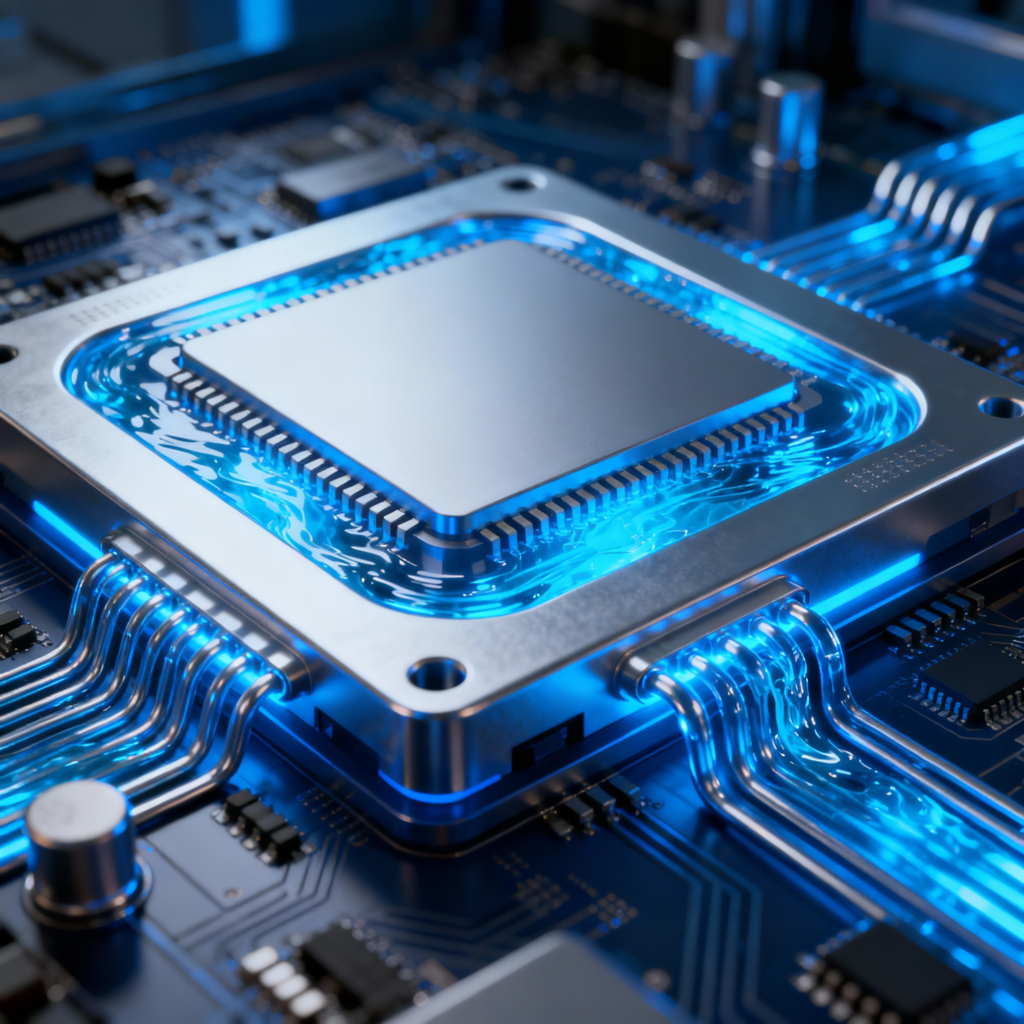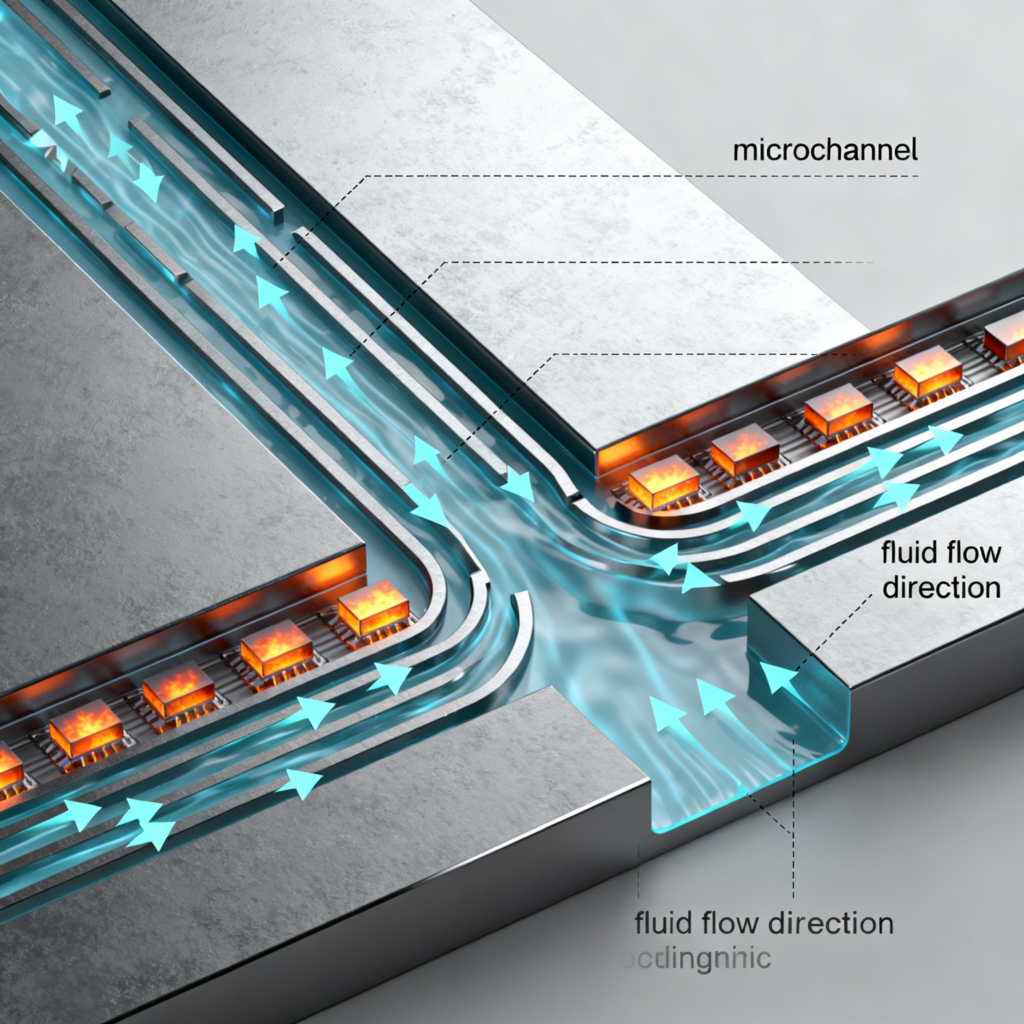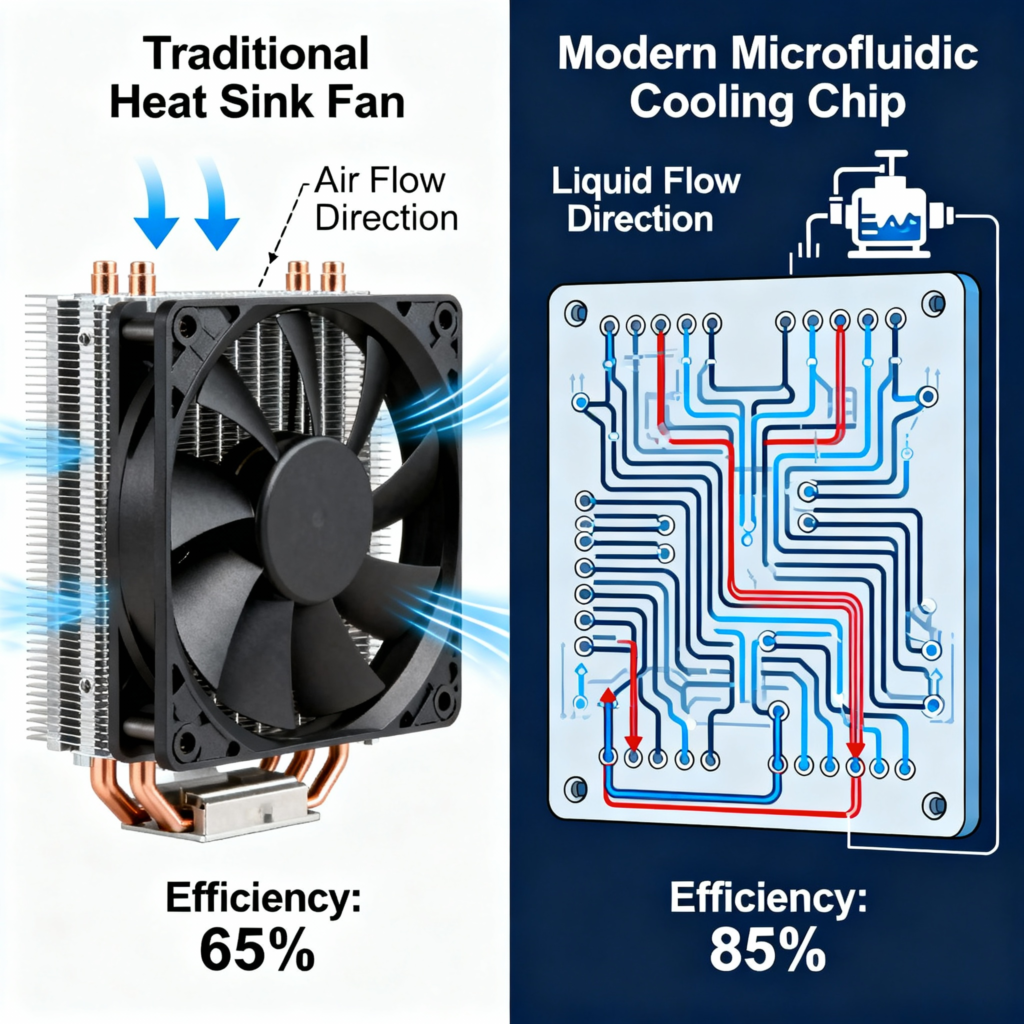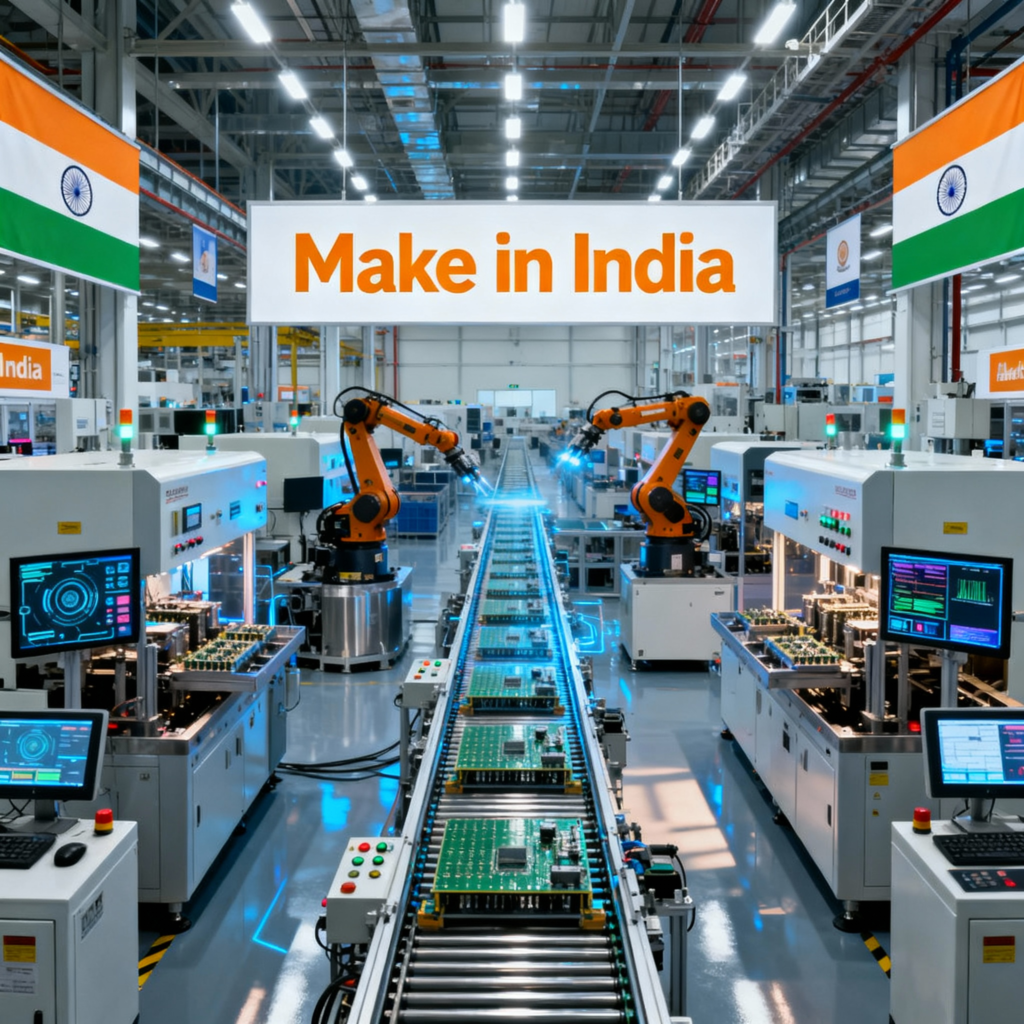Key Highlights
Revolutionary Efficiency: Microfluidic cooling achieves 3,000 times higher heat transfer efficiency than conventional methods, with thermal resistance as low as 0.064 K/W
Strategic Applications: Technology proves critical for defense systems, satellites, medical equipment, AI hardware, and high-performance computing
India’s Opportunity: Aligns perfectly with India Semiconductor Mission, Make in India, and PLI schemes—offering pathway to technological self-reliance
Manufacturing Momentum: India approved ₹1.52 lakh crore semiconductor investments with first domestic chip expected by end 2025
Policy Imperative: Success requires coordinated investment in R&D, industry-academia partnerships, supply chain localization, and workforce development
A Game-Changing Breakthrough in Thermal Management
In an era where electronic devices are shrinking while performance demands skyrocket, managing heat has become one of technology’s most critical bottlenecks. Enter microfluidic cooling—a revolutionary innovation that could redefine electronics manufacturing globally and offer India a strategic edge in its quest for technological self-reliance. ieeexplore.ieee
Scientists have developed a microfluidic cooling device that achieves 3,000 times higher efficiency in heat dissipation compared to conventional cooling methods. This breakthrough technology uses microscopic channels—each barely 0.9mm thick—to circulate cooling fluids directly at heat hotspots within electronic components, dramatically outperforming traditional fans and heat sinks.

The Science Behind Microfluidic Cooling
Understanding the Technology
Traditional cooling systems rely on air circulation through fans and metal heat sinks—technologies that are reaching their physical limits as devices become more compact and powerful. Microfluidic cooling takes a fundamentally different approach by etching microscopic channels directly onto the back of silicon chips.
These hair-width microchannels allow coolant to flow precisely where heat generates, creating an efficient thermal highway that removes heat up to three times more effectively than cold plates. The system achieved remarkable results in laboratory tests, reducing maximum GPU temperature rise by 65 percent while requiring only 0.9 W/cm² of pumping power.

Technical Specifications and Design
The microfluidic device consists of a three-layer architecture with jet-enhanced manifold microchannels. Researchers at institutions like Peking University have demonstrated systems capable of dissipating heat fluxes up to 3,000 W/cm² using single-phase water as coolant. The design leverages AI-optimized channel geometry that mimics patterns found in nature—such as leaf veins and butterfly wings—to guide fluid flow with maximum efficiency.
Advanced fabrication techniques, including picosecond laser etching and nano-silver sintering, enable precise microchannel creation directly beneath chip footprints. This embedded cooling approach represents a paradigm shift from traditional external cooling systems.
Advantages Over Conventional Cooling Methods
Efficiency and Performance Gains

The performance differential between microfluidic cooling and traditional methods is staggering. Where conventional heat sinks achieved a coefficient of performance around 2,000, embedded microfluidic cooling demonstrated values exceeding 20,000—more than a tenfold improvement. Junction-to-fluid thermal resistance dropped to an ultralow 0.064 K/W, representing a 52 percent reduction compared to standard heat sinks.
Conventional cooling versus advanced microfluidic cooling comparison
These efficiency gains translate to practical advantages. The technology allows reliable heat dissipation of 655 W at coolant flow rates of just 3 g/s, while reducing junction temperature gradients by 86 percent. For high-power electronics, this improved thermal management enabled a 43 percent increase in current capacity.
Space and Energy Efficiency
Microfluidic cooling addresses critical spatial constraints in modern electronics. By embedding cooling directly within chip architecture, manufacturers can reduce packaging thickness by up to 40 percent while enhancing heat flux dissipation ability by 61 percent compared to traditional structures. This compactness proves essential for applications from smartphones to defense systems.
Energy efficiency represents another crucial advantage. The self-adaptive nature of advanced microfluidic systems allows cooling intensity to adjust automatically based on real-time thermal loads, reducing operational costs while preserving cooling effectiveness. Reduced reliance on bulky air cooling systems offers environmental benefits through lower energy consumption.
Applications Across Critical Sectors
Consumer Electronics and Computing
Microfluidic cooling enables sustained high performance in increasingly miniaturized electronics. Applications span computers, mobile devices, and advanced AI hardware where power density continues to climb. Microsoft’s successful testing of microfluidic cooling in datacenters demonstrated viability for servers running core services, with systems handling workloads three times more effectively than cold plate technology.
The technology also facilitates controlled overclocking during demand spikes without damaging silicon, improving server performance while reducing infrastructure costs. For flexible electronics—including wearable devices and electronic skins—embedded microfluidic cooling with flexible manifolds manages thermal accumulation while maintaining bendability and reliability.
Medical Equipment
Medical devices increasingly incorporate high-density electronics requiring sophisticated thermal management. Microfluidic cooling ensures temperature-sensitive medical equipment maintains accuracy and reliability during operation. The technology’s compact form factor and precise temperature control make it particularly valuable for portable diagnostic devices and surgical equipment.
Defense and Strategic Applications

Military and space systems face extreme thermal management challenges. Microfluidic cooling enhances operational reliability for critical assets including radar systems, communications equipment, satellites, and electronic warfare modules.
Defense electronics must withstand hostile environments from desert surfaces to outer space while maintaining peak performance. Advanced radar systems generating heat loads exceeding 150 kW require sophisticated cooling solutions. Microfluidic technology addresses these demands by providing efficient heat removal without mechanical components that might fail in extreme conditions.
For satellite electronics, microfluidic systems offer stable thermal regulation in zero gravity environments while reducing payload weight by 20-40 percent—a critical advantage where every gram matters. The technology’s ability to operate across temperature ranges from -50°C to +125°C with ±2°C stability makes it ideal for aerospace applications.
Implications for India: A Perspective
Science and Technology Development
Microfluidic cooling technology arrives at a pivotal moment for India’s electronics sector. The nation has committed nearly ₹629 billion toward semiconductor production under the India Semiconductor Mission, with the first domestically produced semiconductor chip expected by end of 2025.

India’s electronics manufacturing has achieved extraordinary growth, emerging as the third-largest and fastest-growing export category in 2024-25. Mobile manufacturing units expanded from just two in 2014 to over 300 today, demonstrating rapid scalability. However, domestic value addition in smartphones remains just 17-18 percent of the Bill of Materials, highlighting dependence on imported components.
Strengthening Indigenous Manufacturing Capabilities
Adopting advanced cooling technologies aligns perfectly with India’s Digital India, Make in India, and Production-Linked Incentive (PLI) schemes. The government approved the Electronics Component Manufacturing Scheme with ₹22,919 crore funding to make India Atmanirbhar (self-reliant) in electronics supply chains.
This scheme aims to attract ₹59,350 crore in investments, generate production worth ₹4,56,500 crore, and create 91,600 direct jobs. By developing indigenous expertise in microfluidic cooling and related thermal management technologies, India can increase domestic value addition and reduce reliance on imports.
Export Competitiveness and Investment Attraction
Mastering advanced cooling technologies positions India to capture high-value segments of global electronics manufacturing. Foreign direct investment exceeding USD 4 billion has flowed into India’s electronics sector since FY 2020-21, largely from PLI scheme participants. Indigenous thermal management capabilities would further strengthen India’s appeal as a manufacturing destination. india-briefing
Major semiconductor projects receiving approval include facilities by Tata Electronics, Micron Technology, CG Power with Renesas, and HCL-Foxconn joint ventures. These represent combined investments nearing ₹1.52 lakh crores, signaling strong momentum in India’s semiconductor ambitions. Integrating advanced cooling technologies into these facilities would enhance competitiveness from inception.
Defense and Strategic Autonomy
For national security, indigenous thermal management capabilities carry strategic importance. Defense electronics spanning radar systems, communications networks, satellites, and weapons systems require reliable cooling under harsh operational conditions.
Current defense thermal management often relies on foreign technologies, creating vulnerabilities in supply chains and limiting customization for Indian conditions. Developing domestic expertise in microfluidic and advanced cooling systems would reduce this dependency while enabling integration with India’s growing defense manufacturing ecosystem.
Space applications represent another strategic domain. The Indian Space Research Organisation (ISRO) and defense satellites require sophisticated thermal control for electronics operating in extreme environments. Indigenous cooling technologies would enhance mission reliability while supporting India’s expanding space ambitions.
Policy Recommendations and Strategic Pathways
Research and Development Investment
India must prioritize domestic research in microfluidics, nanofluidics, and advanced materials science. Establishing dedicated research centers within premier institutions like IITs and NITs, focused on thermal management technologies, would accelerate capability development.
The government should expand funding mechanisms like the Electronics Development Fund to specifically support cooling technology research. Collaboration between India Semiconductor Mission and thermal research initiatives would ensure alignment between chip manufacturing and cooling solution development.
Industry-Academia Partnerships
Successful technology adaptation requires robust collaboration between research institutions and industry. The government should incentivize partnerships where academic researchers work directly with electronics manufacturers to customize microfluidic cooling for Indian applications.
Programs facilitating technology transfer from international leaders to Indian institutions—while ensuring intellectual property rights—would accelerate learning curves. Joint development projects with countries possessing advanced microfluidic expertise could establish knowledge pipelines.
Infrastructure and Manufacturing Ecosystem
Developing domestic capability to fabricate microfluidic devices requires specialized equipment and materials. India should leverage existing semiconductor fabrication facilities being established under India Semiconductor Mission to integrate cooling device production.
The government’s SPECS (Scheme for Promotion of Manufacturing of Electronic Components and Semiconductors) provides 25 percent capital expenditure incentives for components and specialized sub-assemblies. Expanding this to explicitly cover advanced cooling components would catalyze domestic manufacturing.
Standardization and Regulation
Establishing national standards for thermal management technologies ensures quality, safety, and interoperability. The Bureau of Indian Standards should develop specifications for microfluidic cooling devices covering performance metrics, safety protocols, and environmental impact.
Regulatory frameworks must address coolant handling, disposal, and potential environmental concerns. Clear guidelines would provide industry certainty while protecting ecological interests.
Skill Development and Workforce Training
Advanced thermal management technologies require specialized skills spanning microfabrication, fluid dynamics, materials science, and thermal engineering. India’s Skill India initiative should incorporate modules on microfluidics and thermal management.
Universities must update curricula to include microfluidic design, nanofluid synthesis, and thermal simulation software. Vocational training programs should prepare technicians for manufacturing and maintaining advanced cooling systems.
Challenges and Strategic Considerations
Manufacturing Scale-Up and Cost Competitiveness
Transitioning microfluidic cooling from laboratory prototypes to mass production presents significant challenges. Current fabrication methods using advanced lithography and laser etching require substantial capital investment.
Achieving cost competitiveness with established cooling methods demands economies of scale. India must balance performance advantages against price sensitivity in consumer electronics markets. Strategic focus on high-value applications—defense, medical, and advanced computing—where performance justifies premium pricing may provide initial market entry.
Supply Chain Dependencies
Microfluidic cooling requires specialized materials including high-purity coolants, advanced polymers for channels, and precision silicon substrates. India currently imports many of these materials, creating supply chain vulnerabilities.
The government should prioritize domestic production of critical cooling system components under the Atmanirbhar Bharat initiative. Mapping material requirements and identifying domestic sourcing alternatives would strengthen supply chain resilience.
Reliability and Long-Term Performance
Long-term reliability remains a critical concern for microfluidic cooling systems. Issues like coolant leakage, microchannel clogging from particle accumulation, and chemical degradation of materials over time require rigorous testing.
Defense and space applications demand extreme reliability where cooling system failure could cause mission-critical consequences. India must establish comprehensive testing facilities capable of simulating harsh operational environments before deploying these technologies in strategic systems.
Intellectual Property and Innovation
While learning from global leaders, India must develop independent intellectual property to avoid long-term dependencies. Supporting domestic researchers to file patents in microfluidic cooling technologies would build innovation pipelines.
The government should balance technology transfer agreements that bring immediate expertise with incentives for indigenous innovation creating uniquely Indian solutions. Protection mechanisms ensuring Indian startups and researchers retain control over their innovations are essential.
Way Forward: From Adoption to Leadership
Short-Term Actions (1-3 Years)
Immediate priorities include establishing pilot programs integrating microfluidic cooling in select electronics manufacturing facilities. Government labs and defense establishments could serve as early adopters, providing real-world testing grounds.
India should rapidly expand research collaborations with institutions like Peking University, Microsoft Research, and Swiss startup Corintis—global leaders in microfluidic cooling. These partnerships would transfer knowledge while Indian researchers develop context-specific adaptations.
Medium-Term Goals (3-7 Years)
By 2028-2030, India should aim for domestic production of microfluidic cooling devices for high-priority sectors including defense electronics, medical equipment, and advanced computing. Integration into semiconductor fabs being established under India Semiconductor Mission would demonstrate technological maturity.
Developing indigenous design tools and simulation software for microfluidic cooling optimization would reduce dependence on foreign platforms. Supporting Indian startups focused on thermal management technologies through dedicated funding windows would catalyze entrepreneurial innovation.
Long-Term Vision (7-10 Years)
By 2032-2035, India should emerge as a significant player in advanced thermal management technologies. Achieving this requires sustained investment, policy support, and ecosystem development.
Establishing India as an exporter of microfluidic cooling technologies—not merely a consumer—represents the ultimate goal. This vision aligns with broader ambitions of achieving a $500 billion domestic electronics manufacturing ecosystem by 2030-31.
Conclusion: Cooling the Path to Technological Leadership
Advanced thermal management represents far more than an engineering challenge—it embodies India’s technological aspirations and strategic imperatives. Microfluidic cooling technology offers a transformative opportunity to leapfrog conventional approaches, enabling smaller, more powerful, and more reliable electronic devices.
For India, mastering this technology means strengthening defense capabilities, enhancing electronics exports, attracting global investments, and building genuine technological self-reliance. The convergence of India Semiconductor Mission, Production-Linked Incentive schemes, and Atmanirbhar Bharat initiatives creates an unprecedented policy environment for such breakthroughs.
Success requires visionary leadership, sustained investment, robust industry-academia collaboration, and unwavering commitment to indigenous innovation. By proactively embracing advanced thermal management technologies today, India positions itself not merely as a manufacturing destination but as a fountain of innovation—capable of defining global technological standards tomorrow.
What are your thoughts on microfluidic cooling technology? Could this innovation revolutionize India’s electronics sector? Share your insights and join the conversation below!









Very well explained.